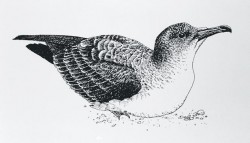It’s Wedgie Season
Nene O Molokai News Release
October and November is fledging season for wedge-tailed shearwaters. “Wedgies,” as they are affectionately called by wildlife biologists, are part of a mixed flock of seabirds that commercial fishermen rely upon to locate schools of ahi and other marketable fish. Young birds fledge from burrows excavated into coastal cliffs to life at sea. The uau kani, or wedge-tailed shearwater (Puffinus pacificus), is 17 inches in length from bill to tip of tail, with a wingspan of 38 inches. Adult birds leave coastal colonies at dawn to feed on fish and return after dark. Behavior while in these colonies is generally nocturnal and throughout the night birds emit weird moans, groans, and loud screams, thus they are nicknamed the “moaning bird.”
Wedge-tailed shearwaters nest on all the major and offshore islands in the Hawaiian chain by digging a burrow with their bill and feet or utilizing natural crevices: nesting sites are reused from year to year. The largest colony on Molokai lies hidden in the dunes of The Nature Conservancy’s Mo`omomi Preserve. It was discovered on Sept. 26, 1999 by Arleone Dibben-Young and U.S. Fish and Wildlife’s Calvin Willis while teaching students about Hawaii’s coastal plants. The colony is now actively managed by Nature Conservancy staff, resulting in more than 400 young birds fledged per season.
Egg laying begins mid-June, with one bright white egg forming the clutch. Parents share the 53-day incubation period, usually in stints of seven to 10 days, and sometimes sit side-by-side. Chicks are fed fish once a day by regurgitation. Parents leave the nest site two to three weeks before their young have fledged (which takes approximately 100–115 days). Shearwaters are clumsy on land; legs are placed so far to the rear of the body that they cannot walk, so instead waddle.
Young birds not yet capable of flight may wander from their burrows in search of food. At this time they are highly vulnerable to predators and often fall prey to mongoose, cats and dogs. Some young birds starve to death while waiting for their feathers to grow to flight length. Many fledglings are attracted at night by urban lights and fall into residential areas or onto highways where they are struck by automobiles.
Statewide community efforts assist in the recovery and release of several hundred juvenile seabirds annually. Chicks that have wandered too far from the nest and are not yet capable of flight must be briefly held in captivity by State and Federal permitted wildlife rehabilitators. When ready for release, birds are fitted with a U.S. Geological Survey metal bird band. If you find a “downed” seabird, call Arleone at 553-5992.












Don't have a Molokai Dispatch ID?
Sign up is easy. Sign up now
You must login to post a comment.
Lost Password